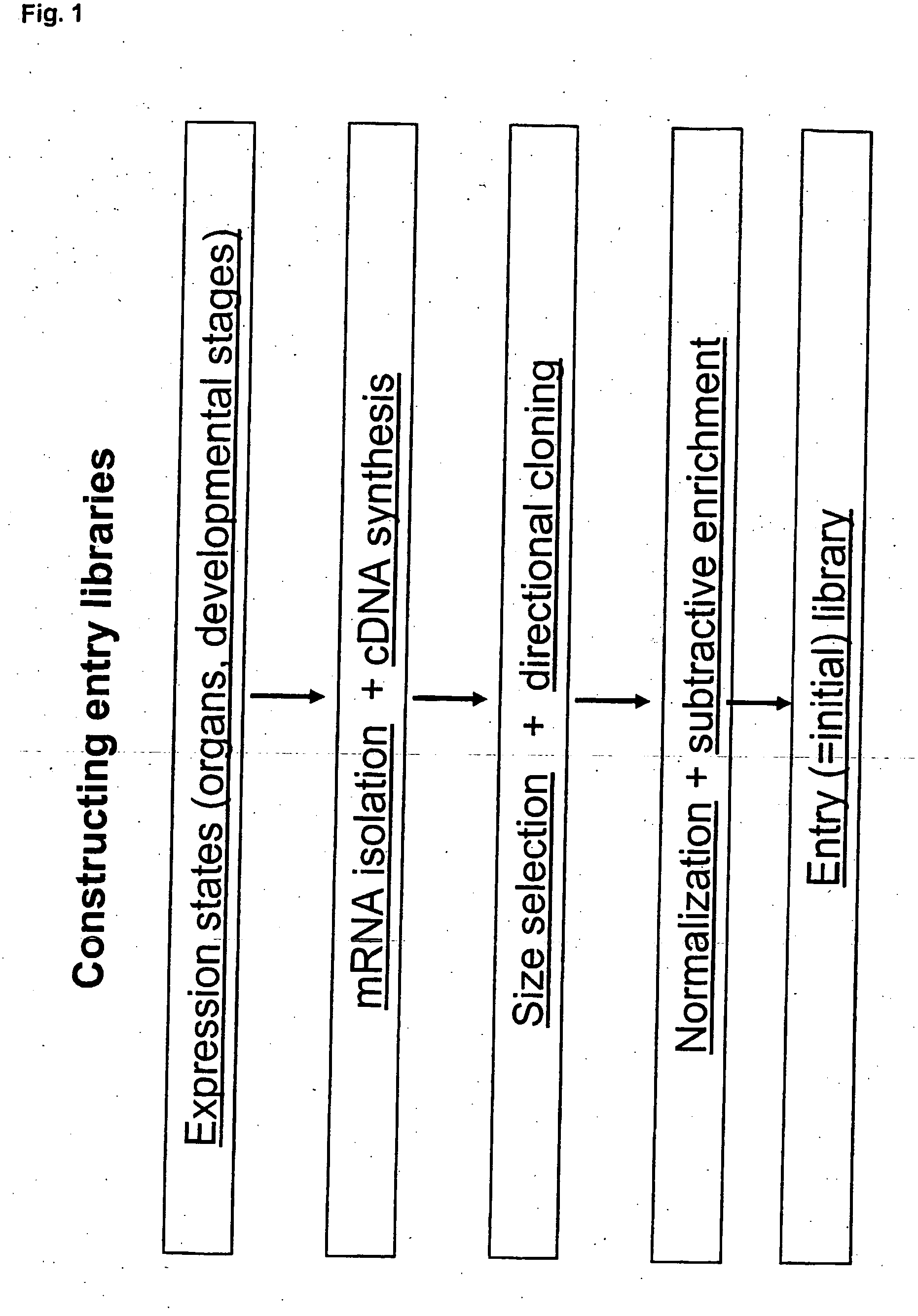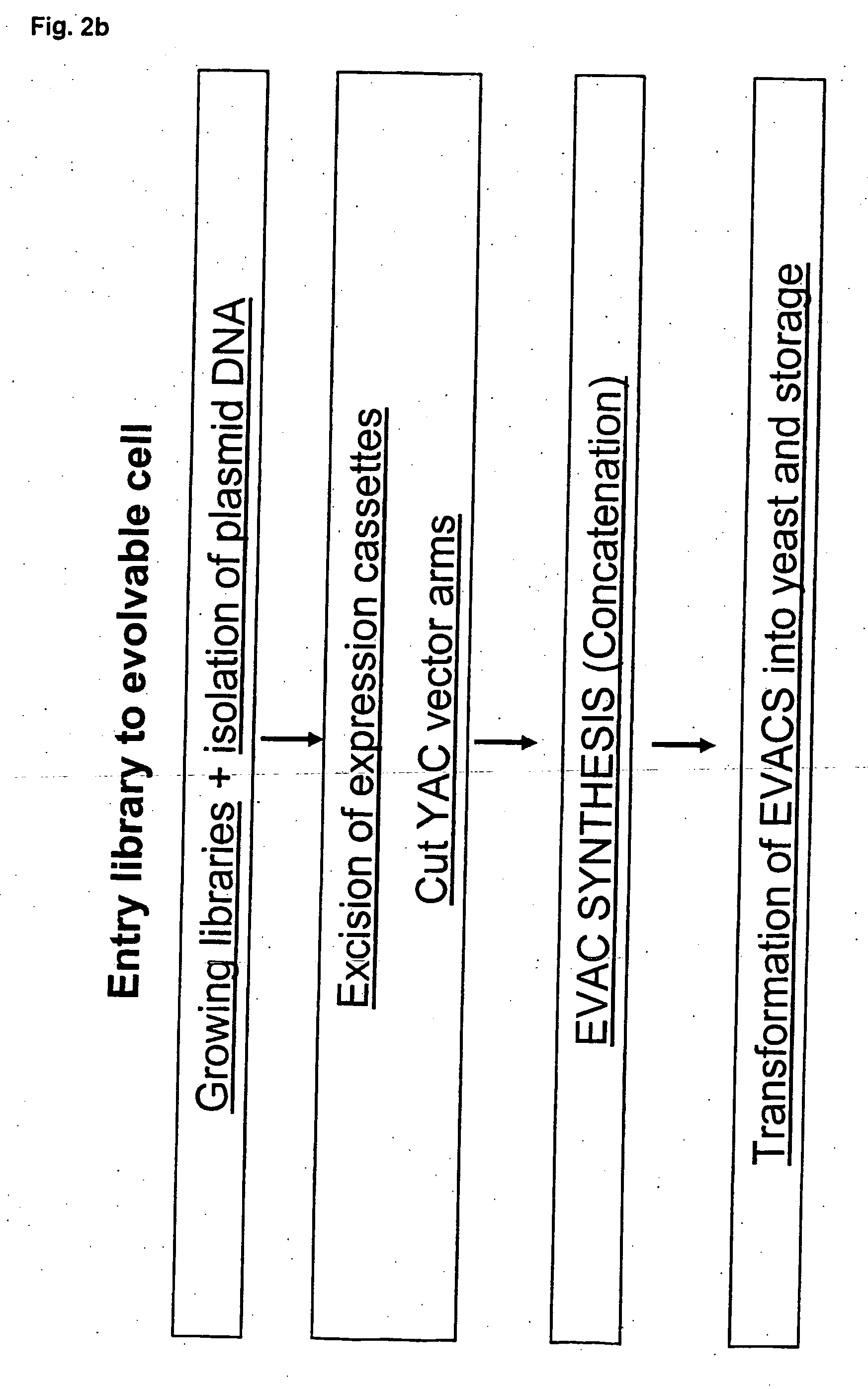Method for evolving a cell having desired phenotype and evolved cells
a cell and genome technology, applied in the field of cell evolution, can solve the problems of inability to optimise the number of genes that cooperatively confer a single phenotype, and the traditional approach only leads to a very limited number of combinations or permutations in or cells or even for a single gen
- Summary
- Abstract
- Description
- Claims
- Application Information
AI Technical Summary
Benefits of technology
Problems solved by technology
Method used
Image
Examples
example 1
Evolution of Carotenoid Like Compounds
Utility
[0729] Carotenoids are natural pigments displaying yellow, orange, pink, red and blue colours. A major role is protection against oxidative damage. Carotenoids are both pharmaceutically relevant (used to treat bronchial asthma and involved in the prevention of cancer) and of commercial value.
Screening & Selection Strategy
[0730] Production of a different colour by host cell. Screen done using a fluorescence activated cell sorter (FACS) [0731] Anti-oxidant protection. Screen done using methylene blue as a producer of singlet oxygen species.
Procedure [0732] STEP 1 Essentially full length cDNA libraries are made from the species in the list provided in this example. [0733] STEP 2 cDNA libraries are made using a pool of 4 entry vectors: pEVE4, pEVE5, pEVE8 and pEVE9 in a proportion of 30:30:1:30. See FIGS. 4, 5, 6 and 7. [0734] STEP 3 Each cDNA library is normalised essentially as method 4 described in Bonaldo, M F et al. (1996) Genome...
example 2
Evolution of Omega Fatty Acid Like Compounds
Utility
[0803] Unsaturated fatty acids are important components for normal cellular function, are involved in cell membrane fluidity and serve as precursors to eicosanoids, including prostaglandins and leukotrines. In mammals, these eicosanoids are involved in inflammatory responses, regulation of blood pressure, and reproductive function.
Screening & Selection Strategy
[0804] Cell membrane fluidity (Flow cytometry screen) [0805] Tolerance to ethanol (survival assay)
Procedure.
[0806] The same procedure as that described in Example 1 is performed, except that the following changes are made to the following numbered steps [0807] Step 7 The screening population is divided into 2 equal portions. One of the portions is screened for tolerance to ethanol (step 8) and the other for cell membrane fluidity (step 9) [0808] Step 8 Tolerance to ethanol: [0809] a. The screening population is amplified ten times and divided in 10 portions. [0810] b....
example 3
Evolution of Retinoid Like Compounds
Utility:
[0824] Retinoids are derivatives of vitamin A and are modulators of cellular proliferation as well as effectors of morphogenic changes. Activity of retinoids as antineoplastic agents has been demonstrated in several in vivo experimental carcinogen models (mainly for skin, respiratory tract, urinary bladder, breast, digestive tract) Cellular responses to retinoids are generally mediated by two families of nuclear receptors (RARs and RXRs) that belong to the steroid-thyroid hormone (or nuclear) receptor superfamily and behave as ligand-activated transcription factors that bind as dimers to the cis-acting response elements of target genes.
[0825] Different retinoic acid receptor isotypes display a characteristic pattern of tissue distribution, RARα being the most ubiquitously distributed. RARβ plays an important role in lung development and has been proposed to have a tumour suppressor function in lung.
Screening & Selection Strategy
[082...
PUM
| Property | Measurement | Unit |
|---|---|---|
| Temperature | aaaaa | aaaaa |
| Composition | aaaaa | aaaaa |
| Strength | aaaaa | aaaaa |
Abstract
Description
Claims
Application Information
 Login to View More
Login to View More - R&D
- Intellectual Property
- Life Sciences
- Materials
- Tech Scout
- Unparalleled Data Quality
- Higher Quality Content
- 60% Fewer Hallucinations
Browse by: Latest US Patents, China's latest patents, Technical Efficacy Thesaurus, Application Domain, Technology Topic, Popular Technical Reports.
© 2025 PatSnap. All rights reserved.Legal|Privacy policy|Modern Slavery Act Transparency Statement|Sitemap|About US| Contact US: help@patsnap.com



